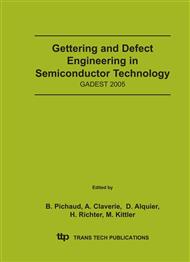p.451
p.457
p.463
p.469
p.477
p.483
p.489
p.497
p.503
Сavity Effect in Hydrogen Ion Implanted Silicon-On-Insulator Structures
Abstract:
Cavity effect on the room-temperature (RT) photoluminescence (PL) from emitting centers in the top silicon layer of silicon-on-insulator (SOI) structure has been studied. The lightemitting centers were produced by the implantation of H+ ions and subsequent annealing at the temperatures Ta = 450-1000 oC for 5 h in an Ar ambient under pressure P = 1 - 1.2×104 bar. It has been obtained that annealing under hydrostatic pressure higher than 6 kbar prevented the outdiffusion of hydrogen in the form of gas bubbles, which took place after annealing at Ta≥600 oC under atmospheric conditions. Absence of micro-pores and gas bubbles in the top surface region creates the conditions to retain the mirror quality of the SOI/air interface. A wavelength-selective effect of the formed cavity on visible PL has been observed from the H+ ion implanted SOI structures annealed under pressure of 12 kbar. The cavity enhancement of PL emission for 23-40 times has been found at the wavelength of 515 and 560 nm.
Info:
Periodical:
Pages:
477-482
Citation:
Online since:
December 2005
Authors:
Keywords:
Price:
Сopyright:
© 2005 Trans Tech Publications Ltd. All Rights Reserved
Share:
Citation:


